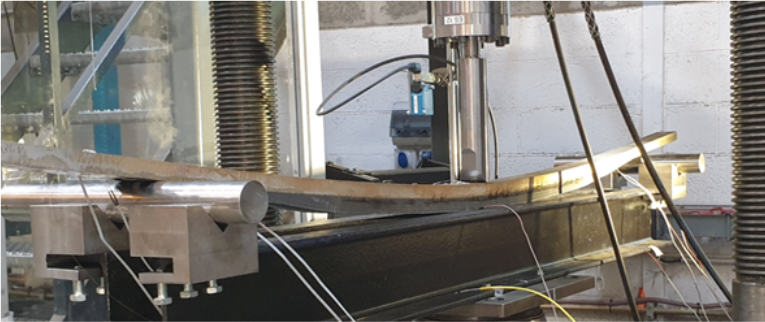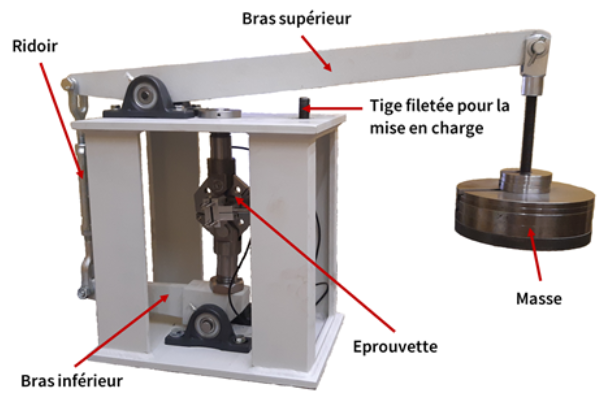Structural Bonding and Composite Materials
For several years, the use of structural bonding and composite materials has been developing in the field of civil engineering, either for reinforcing existing structures (bonded reinforcements, use of bonded connectors, etc.) or for creating new structures. However, there are still challenges to overcome regarding design approaches, and mechanical, environmental, or coupled durability.

Recytiplast: An interdisciplinary sustainable city project with Senegal
If recycling plastic waste in Senegal meets an environmental necessity that requires the development of new technologies, it can also be part of an economic and social approach. This is the challenge of the Recytiplast project, initiated in 2020 and supported by the I-SITE FUTURE as an "Impulsion" project. As a result of a Franco-Senegalese partnership, Recytiplast aims at studying the technical and social feasibility of plastic waste valorization to improve rural construction. Concretely, it is about organizing the transformation of harmful residues into innovative, useful, and profitable materials. "The specificity of Recytiplast is to mobilize both materials science, humanities and social sciences, and local actors. Such a great interdisciplinarity is rare in a research project," notes Laetitia Van Schoors from the CPDM laboratory, who leads the project with Lamine Dieng from the SMC laboratory. The two researchers collaborate, in particular, with the IMT Nord Europe, the University of Le Mans, the NGO Gret, and Senegalese partners such as the Cheikh-Anta-Diop University of Dakar (UCAD), rural communities, and municipalities.
The first step of Recityplast is to determine, through field surveys conducted in 2021 among the populations and local authorities, the type of plastic waste whose physical and chemical characteristics match the identified needs (in this case, the coverage or insulation of habitats). This step involves about thirty meteorologists, hydrologists, hydraulic engineers, economists, and sociologists. The project was funded by ANR for €628,000 and contributes to several international research programs: the HIWeather program of the World Meteorological Organization, which aims at "improving resilience to high-impact weather situations," the HyMeX program on the study of extreme hydrometeorological phenomena in the Mediterranean, and the HEPEX program on ensemble hydrological forecasting.
To meet the challenge of anticipating flash floods, the researchers have designed next-generation prediction chains intended to predict, in the short term (from 0 to 6 hours), rainfall and river flows, potentially flooded areas, and the impacts of floods on the population, insured assets, or road networks. To evaluate the predictions obtained, the researchers replayed fifteen well-documented floods to compare their results with observations. They also discussed with operational actors the usefulness of these new forecasts, with the current warning service "Vigicrues Flash" as a reference: local authorities, civil protection and rescue services, flood forecasting services, insurance companies, and engineering firms.
The second step is to develop manufacturing processes for plastic and sand-based composites and then evaluate their mechanical performance in terms of strength and resistance to UV radiation. The validation of these tests, carried out on the Marne-La-Vallée campus, will make it possible to engage in the project's third step: the production of full-scale parts and their installation. This practical objective is accompanied by a transfer of knowledge so that local actors can appropriate and extend their development. To support this approach, the design and manufacture of a machine dedicated to on-site production of recycled materials is under study.

SBO project
Environmental constraints in the marine environment lead to various types of damage to metal structures, mainly corrosion and fatigue. The need to prevent, repair, and control these damages has led to the development of several techniques. The most common technique, which involves cutting out damaged parts and replacing them with newly welded pieces, is unsuitable if the area is considered "at risk" with regard to fires. The example of oil or gas tankers whose use of welding equipment requires the inerting of large surfaces highlights the need to find new "cold" methods to repair corroded or cracked areas. More and more solutions for strengthening or repairing offshore metal structures using bonded materials are being proposed to shipowners. This requires being able to evaluate, characterize, and determine the capacities of the used assemblies under different modes of stress. In this context, the SMC laboratory, in collaboration with the SII laboratory, hosted a thesis on the subject of evaluating strategies for the design of composite reinforcements bonded to offshore metal structures (thesis by Q. Sourisseau) and then a post-doctoral contract. The work aimed at developing an evaluation methodology based on fracture mechanics (mode I, II, and mixed) using fiber optic instrumentation. The project is led by Bureau Veritas and carried out in collaboration with TOTAL, Petrobras, Naval Group, Siemens, ColdPad, and Infracore.

Creep behavior of bonded assemblies
COLD PAD is a company specialized in reliable structural bonding. It has developed several industrial products sold in the oil industry, including C-Claw: a bonded plate, industrially implemented using a power tool to secure cable trays, pipe supports, pads, handrails, ladders, electrical equipment... These equipment must withstand creep loads in service.
After preliminary work aimed at characterizing the mechanical behavior of bonded connectors for a given geometry, a thesis was carried out to understand the creep of connectors assembled by structural bonding regardless of the type of loading and taking into account the effect of the environment on it (Durability of bonded connectors subjected to creep loading for submarine applications). In the case of the studied C-Claw connectors, sealing being ensured, the effect of the studied environment will be that of temperature. This work was carried out in collaboration with ColdPad and ENSTA (R. Creach'cadec) and co-financed by ColdPad and the DGA. It led to the development of new creep testing devices on bonded joints.

FASSTBRIDGE project
FASSTBRIDGE is a 24-month project funded under the European ERA-NET Plus Infravation program. It took place between 2015 and 2019 and involved the participation of eight partners: a Spanish research laboratory Tecnalia, who coordinated the project, a German engineering firm LAP, an American consulting firm Altavista, a Spanish construction group Dragados, an Italian polymer formulator Collanti, a Spanish infrastructure manager, the Madrid County Council, and two public research laboratories: the University of Stuttgart (MPA) and IFSTTAR (CPDM, EMMS, Navier, SDOA, and SMC laboratories).
The project aimed at developing, assessing, and implementing a preventive solution for strengthening metallic structures against fatigue. To achieve this, a comprehensive methodology was defined, including the evaluation of residual life, design of the reinforcement, and instrumentation. Then, a composite strengthening system was proposed, including the development of an adhesive, laboratory testing, and recommendations for implementation, as well as various methods for evaluating the solution's economic and environmental impact. All of these tools were applied to a real structure belonging to the Madrid County Council. This allowed verifying the relevance of the developed tools, the proposed strengthening method, and its feasibility.